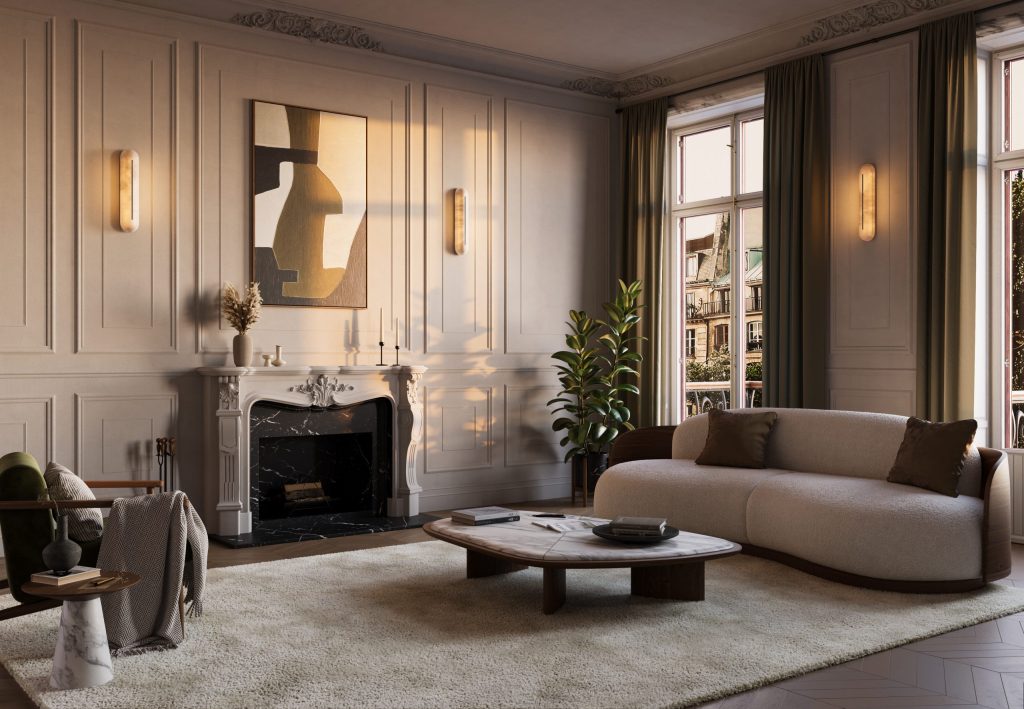The Impact of Lighting on the Perception of Small and Minimalist Spaces

Illuminating Small Spaces
Effective lighting can transform a small or minimalist space from cramped to welcoming. Understanding how lighting influences perception allows homeowners and designers to create environments that feel more spacious and inviting. In an era where urban living often means limited square footage, this topic becomes increasingly relevant.
Key Considerations in Lighting Design
Consider the following elements of lighting that can significantly impact small spaces:
- Natural light: Maximizing daylight through windows opens up a room. This can be achieved by choosing sheer curtains that let in abundant light while maintaining privacy. For instance, apartments in cities like New York often utilize light-colored paint and strategically placed mirrors to reflect natural light, making the area feel larger than it is.
- Layered lighting: Combining ambient, task, and accent lighting creates depth. Ambient lighting provides overall illumination, such as ceiling fixtures or recessed lights. Task lighting, like desk lamps or under-cabinet lights in kitchens, serves specific functions and helps to delineate areas. Accent lighting, such as wall sconces or spotlights on artwork, draws attention to particular features, enhancing visual interest and depth.
- Color temperature: Warm light tends to make spaces feel cozier and more inviting. For example, using bulbs with a color temperature around 2700K can subtly influence the mood in a living area or bedroom to feel more inviting compared to the harsher light of cooler tones, which can be unwelcoming in small spaces.
Incorporating these aspects can enhance the functionality and aesthetic of a space. Understanding the psychology of light brings about a deeper appreciation for interior design, especially in settings where every square inch counts. Warm light can also stimulate serotonin production, improving mood and productivity in small home offices where many Americans find themselves working remotely.
What Lies Ahead
This exploration will delve into how various lighting strategies can elevate the perception of small and minimalist environments. From choosing the right fixtures to the strategic placement of light sources, the journey through the world of lighting design opens up new possibilities for creating the ideal living space. In particular, innovative solutions, such as LED strip lights and smart lighting systems that can be controlled via smartphone, are becoming increasingly popular, allowing residents to tailor their lighting according to different times of day or activities.
As we progress, we’ll examine real-life examples and case studies from various urban settings that illustrate how effective lighting design can effectively maximize small spaces while providing comfort and aesthetics. By understanding these strategies, readers can discover the transformative potential that appropriate lighting holds for their own homes.

CHECK OUT: Click here to simplify your to-do list
Transformative Effects of Lighting in Small Spaces
Lighting plays a crucial role in shaping how we perceive our surroundings, particularly in small and minimalist spaces. The way light interacts with elements within a room can drastically alter our perception of size, ambiance, and functionality. Effective lighting design not only enhances aesthetic appeal but also contributes to the psychological comfort of the inhabitants. In urban dwellings, where space is often at a premium, understanding the nuances of lighting can yield significant benefits.
Creating an Illusion of Space
One of the foundational aspects of lighting in small areas is its ability to create an illusion of more space. This can be achieved through various techniques:
- Mirrors: Incorporating mirrors in conjunction with lighting can dramatically amplify the perception of space. When strategically placed opposite sources of natural or artificial light, mirrors reflect light, making the area appear larger and more open.
- Directing Light Upward: Using uplighting, such as floor lamps or wall-mounted fixtures that cast light toward the ceiling, helps to visually lift the space. This technique encourages the eye to travel upward, creating a sense of height and spaciousness.
- Using Light Colors: Light-colored walls and furnishings coupled with adequate lighting can contribute to an airy atmosphere. Bright, reflective surfaces enhance the diffusion of light, further emphasizing the spaciousness of small rooms.
Utilizing these tactics, homeowners can skillfully manipulate their living environments. For instance, many compact apartments in cities like San Francisco often highlight these aspects, with residents employing soft ambient lighting and smart use of mirrors to create inviting, den-like havens.
Psychological Impact of Lighting on Mood
The way light is deployed within a small space doesn’t only affect its physical dimensions; it can significantly influence the mood and behavior of those who inhabit it. Research has shown that exposure to specific lighting conditions can enhance focus, creativity, and even relaxation. For small spaces that serve multiple functions, such as living and working areas, a tailored lighting strategy is paramount.
Consider a home office in a compact apartment. Warm lighting can encourage productivity and reduce strain on the eyes, making long hours spent working feel less taxing. Conversely, harsh or overly cool lighting can create distractions, leading to feelings of discomfort or irritability. By opting for adjustable fixtures that allow for variation in brightness and warmth, residents can customize their environments in real time, aligning their space with their daily activities.
As we investigate further, the implications of lighting choice become clear: it’s not merely a matter of illumination, but a fundamental component of spatial perception and emotional well-being. Ultimately, understanding how to effectively harness light can transform any small area into a warm, inviting haven that balances both functionality and aesthetics.
The Role of Artificial Lighting
Artificial lighting plays a crucial role in enhancing the aesthetic appeal of small and minimalist spaces. The type, intensity, and placement of light fixtures can dramatically alter how a space is perceived. For instance, soft, warm lighting can create a cozy atmosphere, making a small room feel inviting and larger than it is. Conversely, harsh, cool lighting may lead to a perception of sterility, often making the space feel more constricted and uncomfortable.Different types of fixtures—such as recessed lighting, pendant lamps, and wall sconces—can be utilized to effectively distribute light throughout a room. Layering various light sources can enhance visual interest and depth, drawing attention to key features while managing shadows effectively. This layering approach adds complexity and dimension to minimalist decor, making it essential for homeowners or designers looking to maximize small spaces.The color of the light bulb is also significant. Warmer tones tend to enhance earthy palettes, commonly found in minimalist design, while cooler tones can either invigorate a space or contribute to a more minimalist aesthetic, depending on how they are used. Having control over the light’s color temperature allows for the manipulation of moods and perceptions in a small area, and ensuring an appropriate balance is key to achieving harmony.
Natural Light Considerations
Incorporating natural light into minimalist spaces can elevate not only the look but also the feel of these areas. Large windows, skylights, and strategically placed mirrors can maximize daylight and provide a sense of openness. The interplay between natural and artificial lighting creates a dynamic environment, allowing for a seamless transition between day and night aesthetics. This relationship transforms small spaces from confining to liberating, reinforcing the idea that good lighting design is fundamental in small and minimalist environments.Overall, understanding the impact of both natural and artificial lighting is vital for anyone interested in the design realm. By thoughtfully considering these aspects, one can significantly enhance the perception of space, creating an atmosphere that feels more expansive and visually appealing.
DIVE DEEPER: Click here for insightful communication hacks
The Role of Natural Light in Small Spaces
While artificial lighting is a critical aspect of design, the role of natural light cannot be overstated, particularly in small and minimalist environments. Sunlight not only enhances the perception of space but also adds character and warmth. Maximizing natural light can transform a cramped area into a more inviting space.
Harnessing Natural Light
To make the most of natural light, strategic window treatment choices can play a significant role. Lightweight, sheer fabrics allow for daylight to filter through, softening bright rays while maintaining privacy. Additionally, placing mirrors perpendicular to windows can reflect sunlight deeper into a room, amplifying its presence and visually enlarging the area.
Throughout the United States, designs that incorporate abundant natural light are becoming increasingly popular. In cities like Chicago and New York, residents often prioritize apartments with expansive windows or access to balconies where sunlight can flood the living spaces. As a result, these areas appear more expansive and connected to the outdoors, effectively blurring the line between indoor and outdoor environments.
Color Temperature and its Effects
Beyond quantity, the color temperature of lighting plays an essential part in perception. Color temperature is measured in Kelvin (K) and impacts the ambiance of a space. Warmer hues (around 2700K to 3000K) evoke feelings of coziness, making areas feel more intimate, whereas cooler tones (4000K and above) can instill a sense of clarity and focus.
In minimalist designs, where the decor is simplified and unobtrusive, selecting the right color temperature can compensate for a lack of vibrant colors within the space. For example, a reading nook in a small apartment may benefit from warm, inviting lighting, while a functional kitchen area can utilize cooler tones for a bright, fresh feel. Balancing these temperatures can create specific zones within a small room, helping to delineate space and function.
Layered Lighting Techniques
Another vital strategy in lighting small spaces is the use of layered lighting—combining ambient, task, and accent lighting to provide versatility. Ambient lighting serves as the primary illumination source, while task lighting focuses on specific areas such as work surfaces or reading spots, and accent lighting highlights artwork or architectural features.
This multi-faceted approach can greatly enhance how a small room feels. For instance, pendant lights over a compact dining table can provide focused illumination for meals, while a floor lamp in the corner can offer ambient light for relaxation. In minimalist environments, such coexistence between different lighting types helps create dynamism without cluttering the visual space.
In conclusion, the intelligent combination of these elements—natural light, color temperature, and layered techniques—can radically alter how individuals perceive and interact with small areas. By leveraging these lighting strategies, residents can create spaces that not only maximize visual potential but also foster an emotionally supportive atmosphere. The ongoing exploration of lighting’s impact holds promise for a redefined experience in urban living, ultimately enhancing both everyday functionalities and aesthetic enjoyment.
DISCOVER MORE: Click here to uncover clever storage solutions
Conclusion: Illuminating Small and Minimalist Spaces
As we have explored, the impact of lighting on small and minimalist spaces is both profound and multifaceted. The interplay between natural light, thoughtful color temperature, and layered lighting techniques creates an essential framework for enhancing the perception of limited areas. By harnessing natural light through strategic window treatments and mirror placements, we can widen and enliven confined spaces, inviting the outdoors in and establishing a sense of connectedness.
Moreover, understanding color temperature allows designers and homeowners to evoke specific moods, making small areas feel either cozy or invigorating depending on the desired atmosphere. This attention to detail helps compensate for the muted palettes often found in minimalist designs, ensuring each zone serves its purpose effectively. Implementing layered lighting not only adds character but also creates functional zones within small environments, allowing versatile use without compromising on style.
As urban living continues to favor compact spaces, the successful marriage of these lighting strategies allows individuals to maximize their home’s potential while enhancing overall well-being. By investing time and thought into the lighting of small and minimalist spaces, one can redefine their living experience, creating a harmonious blend of practicality and aesthetic appeal. The exploration into the art of lighting remains a critical avenue for transforming the way we perceive our homes, encouraging further reflection and innovation in design.


